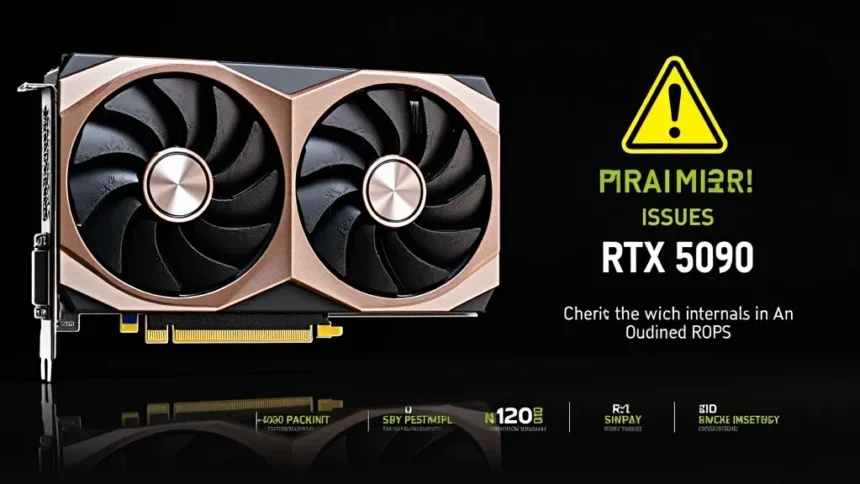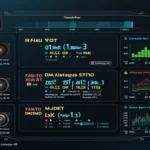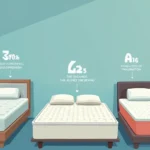Hey there, gamers! If you’ve recently splurged on the Nvidia RTX 5090, you might want to pay attention. Nvidia has confirmed that a tiny fraction of these powerful GPUs, along with the RTX 5070 Ti, are facing some serious hiccups due to a hardware flaw. Imagine expecting top-notch graphics but getting a bit of a letdown instead. This issue revolves around a missing component called ROPs, which are vital for rendering the stunning visuals we all crave in our games. So, let’s dive into what this means for you and how to check if your graphics card is affected!
Understanding the ROP Issue in Nvidia RTX 5090
The recent hiccup with Nvidia’s RTX 5090 and 5070 Ti graphics cards revolves around ROPs, or Raster Operations Pipelines. These components are crucial for rendering graphics smoothly in games. A shortage of ROPs can lead to unexpected performance drops, especially in demanding applications where every bit of processing power counts.
Nvidia has confirmed that about 1 in 200 of these GPUs are affected, meaning the problem isn’t widespread but still significant for those who experience it. The company has acknowledged that some cards may show a performance dip of around 4%, which could be frustrating for gamers expecting top-tier performance from their hardware.
So, what does this mean for gamers? Well, if you’re using an RTX 5090 or 5070 Ti, you might notice a slight decrease in your gaming performance. However, not every game will utilize ROPs equally, so some players might not even feel the impact at all. It’s a bit of a mixed bag.
How to Identify If Your GPU is Affected
If you’re concerned your RTX 5090 might be part of this issue, checking your ROP count is straightforward. You can use GPU-Z, a handy tool that dives deep into your GPU’s specifications. Simply look for the ROPs count in the Graphics Card tab, and you’ll see whether your card is performing as it should.
For the RTX 5090, the expected ROP count is 176, and anything less indicates a potential problem. It’s essential to check this, especially if you’re an avid gamer who relies heavily on graphical performance. Being informed allows you to take action before the issue significantly affects your gaming experience.
If your GPU falls short, don’t panic. Nvidia has advised affected users to reach out to their card manufacturers for a replacement. This means there’s a pathway to rectify the situation, ensuring you get the performance you paid for.
Nvidia’s Response and Production Anomaly
Nvidia has responded promptly to the reports, stating that this issue is a rare production anomaly. They’ve acknowledged the oversight and have corrected the matter moving forward. This shows their commitment to quality and customer satisfaction, even if it means dealing with a hiccup in their flagship line.
The company’s transparency about the situation is commendable. They’ve provided clear guidance on how to identify affected cards and the steps to take if you’re impacted. This level of communication is crucial in maintaining trust with their consumer base.
Despite the unfortunate circumstances, Nvidia assures consumers that future production runs should be free from this flaw. It’s a reminder that even giants like Nvidia occasionally stumble, but they’re quick to address issues when they arise.
Impact on Gaming Performance and User Experience
The performance impact of the ROP issue may not be as severe as one might think. An average decrease of around 4% could be negligible for many gamers, especially if they play less demanding titles. However, for hardcore gamers, even a slight dip can be noticeable in competitive settings.
Different games utilize graphics components in varying degrees. Some titles might push ROPs to their limits, making the loss more apparent, while others may not rely as heavily on them. This variability means that some users might not even notice a difference in their gaming experience.
Ultimately, the perception of performance loss can be subjective. While some players may feel let down by their hardware, others might find that their gaming experience remains largely unaffected. It’s all about individual usage and the types of games played.
Steps to Take If You’re Affected
If you suspect your RTX 5090 or 5070 Ti is affected, the first step is to check your ROPs count using GPU-Z. If you find that your card has fewer ROPs than expected, it’s time to contact your manufacturer. They can guide you through the replacement process.
Reaching out to customer support can be daunting, but knowing that Nvidia has your back can ease the stress. They have established procedures to handle these situations, ensuring that you won’t be left in the lurch. Expect to provide details about your card and the findings from GPU-Z.
Once you’ve initiated the replacement process, keep an eye on Nvidia’s updates. They’ve been proactive about resolving this issue, and staying informed can help you understand what to expect next as they rectify and improve their product lines.
Looking Ahead: Future of Nvidia GPUs
As Nvidia addresses the current ROP issue, the future of their GPU lineup looks promising. With the production anomaly corrected, upcoming models are expected to deliver the high-quality performance that gamers crave without the worry of hidden flaws.
Consumers can look forward to enhanced graphics experiences as Nvidia continues to innovate and refine their technology. Each new generation brings improvements, and the RTX 5090 and its successors are likely to be no exception.
In the end, this situation serves as a learning experience for Nvidia and its customers. By staying vigilant and informed, gamers can ensure they make the most out of their investments in high-performance hardware.
| Issue Description | Details | Impact | |
|---|---|---|---|
| Nvidia RTX 5090 and RTX 5070 Ti GPUs experiencing issues with ROPs | Approximately 1 in 200 GPUs affected | ||
| Loss of Raster Operations Pipelines (ROPs) | ROPs critical for graphics rendering performance. | ||
| Average performance impact is 4% | Some users may notice a performance decrease of up to 5%. | ||
| Affected GPUs | RTX 5090 / RTX 5090D / RTX 5070 Ti | ||
| How to Check | Use GPU-Z to check ROPs count. | ||
| Normal ROPs Count | ROPs for RTX 5090 should be 176; impaired models show 168. ROPs for RTX 5070 Ti should be 96; impaired models may show 88. | ||
Frequently Asked Questions
What does ROP mean and why is it important for my GPU?
ROP stands for Raster Operations Pipeline, and it plays a crucial role in rendering graphics for your gaming experience. Think of ROPs as the workers in a factory that handle the final touches of your graphics—like putting on the last coat of paint. If your GPU has fewer ROPs, it’s like having fewer workers on the job, which can slow down performance during gaming. For the RTX 5090, the expected number is 176 ROPs, whereas some affected models only have 168. This missing capacity can lead to a noticeable dip in performance, especially in graphics-heavy scenarios.
How can I tell if my RTX 5090 or 5070 Ti is affected by this issue?
To check if your GPU is among those affected, you can use a tool called GPU-Z. It’s a handy little program that digs deep into your graphics card’s specs. Simply open GPU-Z, go to the Graphics Card tab, and look for the ROPs count. If your RTX 5090 shows 168 ROPs instead of 176, or if your RTX 5070 Ti shows fewer than 96 ROPs, you might have one of the affected models. It’s as easy as checking the ingredients on a snack package!
What should I do if I find my GPU is affected?
If you discover that your RTX 5090 or 5070 Ti is indeed affected, don’t panic! Nvidia has advised that you reach out to the manufacturer of your graphics card for a replacement. It’s a good idea to act quickly since these issues are a bit of a bummer, and you want to ensure you’re gaming at peak performance. Just think of it like returning a defective product—you want to get back to enjoying your games without the hassle!
How much of a performance hit can I expect from this issue?
The average performance drop for affected GPUs is around 5%. However, this can vary from game to game. In some titles, you might not even notice a difference, while in others, the impact could be more pronounced. It’s like cooking: some recipes require precise measurements, while others allow for a bit of improvisation. So, depending on what games you play, your experience may vary.
Is Nvidia fixing this problem for future GPU releases?
Yes, Nvidia has confirmed that the production anomaly causing this issue has been corrected. So, while it’s a bummer for those affected now, you can feel reassured that future batches of the RTX 5090 and 5070 Ti should be free from these hiccups. It’s like they’ve fixed the assembly line, so the next batch of GPUs should come out without any of these pesky flaws!
Nvidia’s RTX 5090 and RTX 5070 Ti GPUs are facing a rare but significant issue, with about 1 in 200 units experiencing a loss of Raster Operations Pipelines (ROPs). This flaw, which results in a 4-5% performance drop during gaming, means some users might notice their graphics cards underperforming. Nvidia advises those affected to contact their manufacturer for a replacement. If you own one of these models, it’s crucial to check your ROP count using tools like GPU-Z to see if you’re impacted. Don’t let this hiccup ruin your gaming experience—stay informed and proactive!
Got thoughts on Nvidia’s GPU hiccup? 🤔 Drop a comment below! And check out our other tech updates to stay in the loop! 🚀😃🔥













